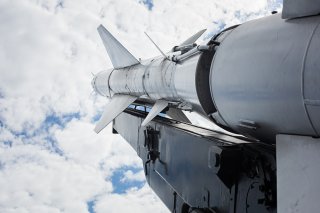North Korea’s Nuclear Weapons Blur the Lines Between Image and Reality
The Kim regime has long viewed symbols and images as a source of power.
When Russian President Vladimir Putin and North Korean supreme leader Kim Jong-un met for their second summit last month in the Russian Far East, there was much discussion about the military consequences, including North Korean weapon sales to Moscow, as the war in Ukraine grinds on and a truce remains out of the question.
Since the end of the Cold War, contact between Moscow and Pyongyang has diminished. Still, the relationship between the two countries should be briefly revisited for context—and to understand how we “got here.”
We can perhaps start on October 14, 1945, when a young ethnic Korean man stepped out before a crowd assembled at Kirimri Stadium in Pyongyang. It was here that Kim Il-sung, a former trainee of the Soviet Red Army, was presented to the Koreans as an “outstanding guerrilla leader.” Kim’s appearance drew public skepticism, but the Russians were determined to position the 33-year-old man as their appointee on the Korean peninsula. To get the job done, they launched a relentless propaganda campaign that blurred the line between fiction and reality. To this day, propaganda plays an instrumental role in bringing the North Korean nation to life. Without Soviet propaganda, the current leader’s grandfather may have been relegated to the ash heap of history.
Kim Il-sung died in 1994, but across the decades of his rule, he leveraged the impact of images and their unlimited reproducibility in the modern age to strengthen his grip on power. He called filmmakers and other artists “engineers of the soul.” His son, Kim Jong-il, shared his father’s passion for the moving image. Kim Jong-il regarded cinema as an essential channel for ideological indoctrination. He instructed North Korean writers to “grasp the seed which fires [their] heart with an unquenchable flame.”
As an educated public, we must understand North Korea’s nuclear weapons stand for many things. They are obviously symbols of the nation’s defense policy. Still, given the regime’s historically heavy reliance on visual representation, we also must consider that they are a form of cultural expenditure that’s taking front and center at a time when the state has diminished its role. Increased marketization is generating change—spurring North Korean migration and movement in the twenty-first century.
Judging by the accounts of most North Korean defectors in the South, the state has achieved very little for its people following a widespread and preventable famine. Weapons of mass destruction have surged in significance for the leadership while grassroots changes continue to spread in the country. Unless the North Korean military loses its domestic role as a symbol of regime solidarity or its international role as a source of persuasive spectacle for the outside world, we should not expect any willingness to give up weapons.
As we have observed over the years, it is through the many apparatuses of postmodern globalization, including online platforms, that North Korea does not so much capture its enemies as captivate them. In doing so, the leadership is again successfully blurring the lines between the real and the imaginary.
Elizabeth Shim is an author and former journalist based in New York City and currently a principal at Haven Tower Group, a strategic communications consultancy. Shim’s forthcoming book, North Korea’s Nuclear Cinema: Simulation and Neoliberal Politics in the Two Koreas (Bloomsbury 2024), is the culmination of nearly a decade of journalism. She has reported for United Press International, Associated Press, and South China Morning Post.
Image: Shutterstock.

